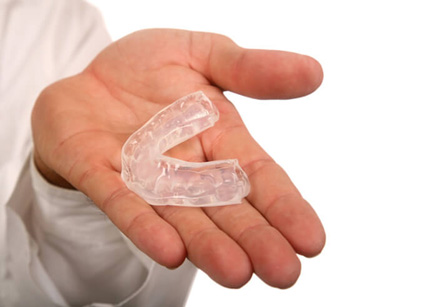Mouth Guard
Introduction
Mouth guards are appliances used for covering the teeth to protect them from injury from teeth grinding and during sports.
There are three types of mouth guards:
1. Stock mouth protectors: they are preformed and ready to wear. They are sold in various departmental and sporting good stores. They are very cost effective. However, their disadvantages are they are bulky, can cause difficulty in breathing and talking, their fitting cannot be adjusted and also they provide a very little protection. Their use is not recommended by dentists.
2. Boil and bite mouth protectors: these are also sold at many sporting goods stores and departmental stores. Fitting of these appliances is better than stock mouth protectors. The boil and bite mouth guard is made of thermoplastic material. When it is placed in soft water, it softens and can be molded around the teeth by using finger and tongue pressure.
3. Custom-fitted mouth protectors: these are designed for individual users. The dentist takes an impression of patient’s teeth and orders the making of mouth guard in a professional dental laboratory. The impression is used in the lab for molding a new mouth guard from a special material. The custom made mouth guard is expensive than the other types due to the use of the special material and due to the extra time and work involved in its making. But this type provides the best fit as well as comfort and protection.
Mouth guards are appliances used for covering the teeth to protect them from injury from teeth grinding and during sports.

A useful mouth guard should be properly fitting, comfortable, resists wear for longer periods and easy to clean as well as maintain. It should not restrict breathing or speech. Usually, the dentist suggests the best mouth guard for the patient. In most cases, mouth guards are used to cover the upper teeth only, but sometimes the dentist advises mouth guard for lower teeth as well (in cases where there are braces or another fixed dental appliance fitted in the lower jaw).
For people who grind their teeth at night, a special mouth guard-type of dental appliance known as a nocturnal bite plate or bite splint is advised to prevent tooth damage.
Candidates for a Mouth Guard:
Mouth guards can be useful to anyone including children as well as adults in activities which can pose a risk of injury to mouth or teeth. These may be:
1. Playing contact sports like football, boxing, soccer, ice hockey, basketball, lacrosse, and field hockey.
2. Non-contact sports like gymnastics
3. Recreational activities like skateboarding, mountain biking.
4. Adults and children having habit of grinding their teeth at night should wear a special nocturnal bite plate or bite splint to prevent damage to teeth.
The purpose of mouth guard in sports:
In any contact or adventure sports, accidents are very common. The advantage of mouth guard lies in that they can limit the risk of injuries to the lips, tongue, and soft tissues in and around the mouth. More severe effects of injury like chipping or breaking the teeth, nerve damage or even tooth loss can also be prevented by the mouth guard.
Other important points:
1. The use of mouth guard is particularly important for people wearing braces or other fixed dental appliances like bridge. Injury to mouth can damage these unique mouth works. The orthodontist or dentist decides about which mouth guard is suitable for this purpose.
2. As far as possible, use of any orthodontic retainers or removable appliance should be avoided during contact sports or any recreational activities as it can put the mouth at risk for injury.
Care for the mouth guard:
1. The mouth guard should be rinsed with cold water or with a mouth rinse before and after each use. It can also be cleaned with toothpaste and a toothbrush.
2. Sometimes, the mouth guard needs to be cleaned by cool, soapy water
3. The container of mouth guard for storage and transport should be firm and perforated. This permits air circulation and helps to prevent damage.
4. Hot water, hot surfaces or direct sunlight can damage the mouth guard and can distort its shape. Therefore it should be protected from exposure to these situations.
5. Intermittently inspect the mouth guard for wear. If any holes or tears are found, it should be replaced.
6. At each dental visit, bring the mouth guard along for scrutiny by the dentist